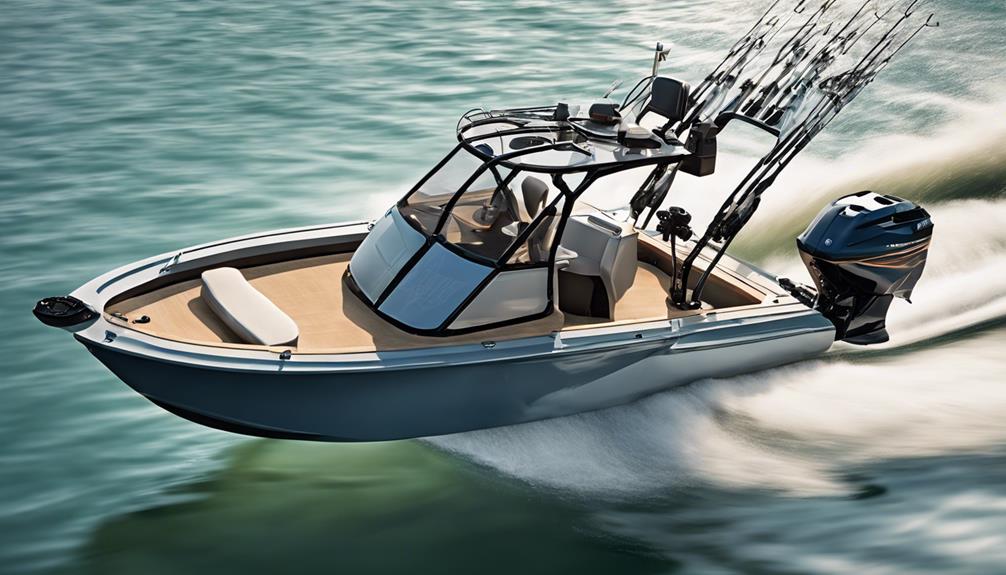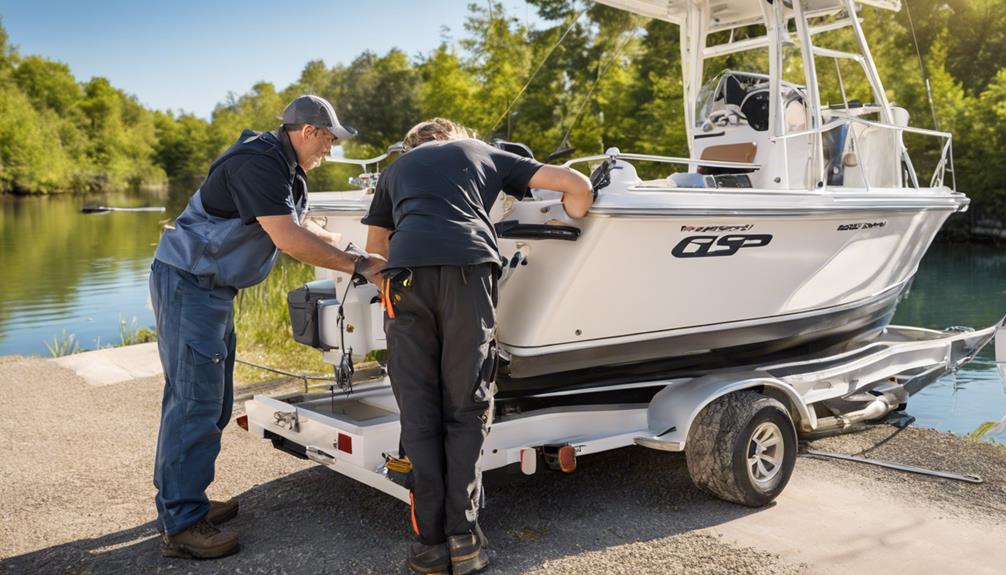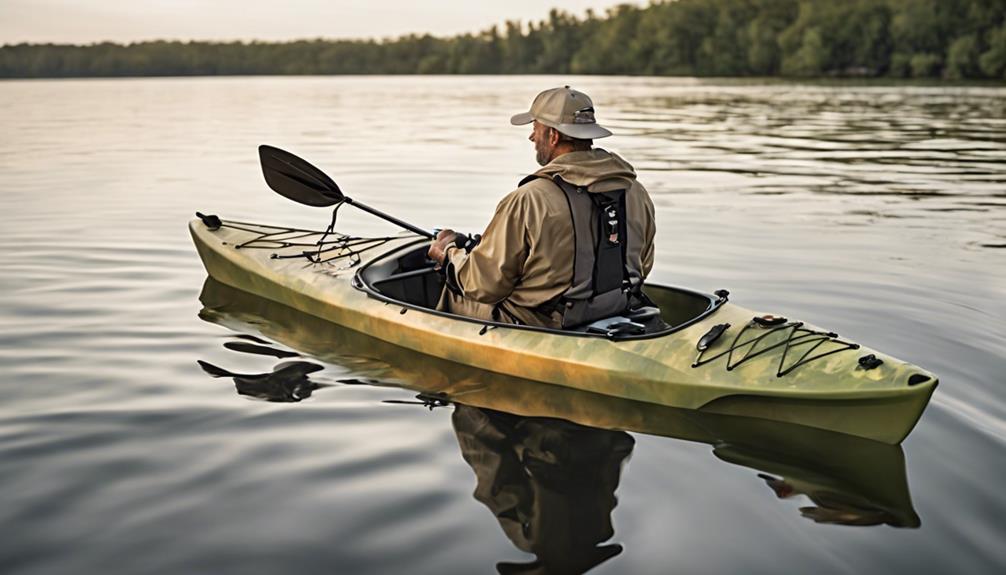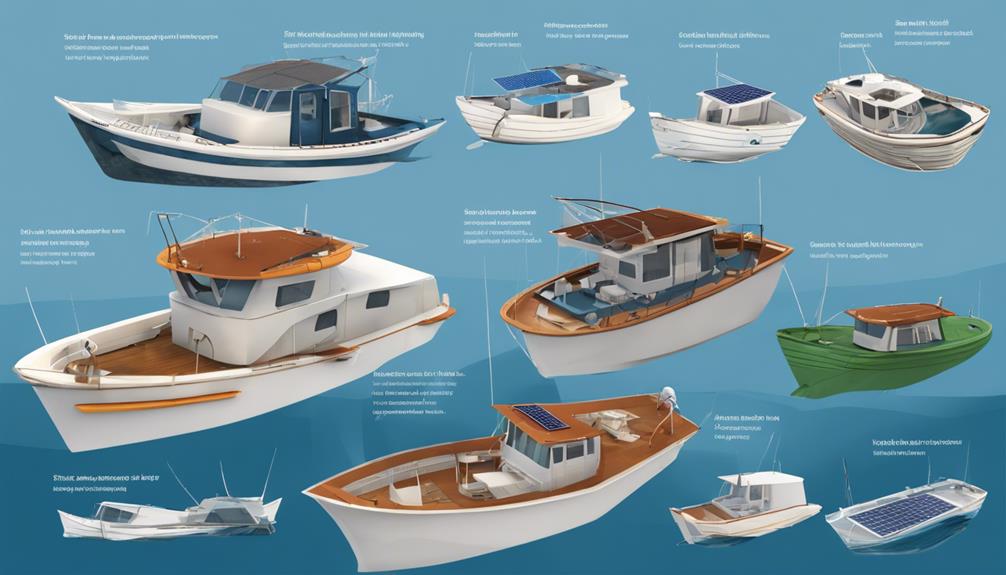Imagine effortlessly gliding through serene waters, casting your line without disturbing the tranquility around you. Picture a scenario where a reliable trolling motor silently propels you to your favorite fishing spot with ease.
Now, what if you could enhance your fishing experience even further? By choosing the perfect trolling motor for your fishing boat, you can elevate your adventures on the water to a whole new level. But how do you navigate the sea of options to find the ideal match for your needs?
Let's explore the key factors together.
Factors to Consider
What key factors should you consider when choosing a trolling motor for your fishing boat?
When looking for the perfect trolling motor, two crucial aspects to keep in mind are motor size and weight capacity. The motor size is essential as it determines the power and thrust of the trolling motor. Depending on the size of your boat and the conditions where you fish, you'll need to select a motor size that provides enough power to propel your vessel efficiently through the water.
Additionally, weight capacity is another vital factor to consider. You must ensure that the trolling motor you choose can adequately support the weight of your boat. Exceeding the weight capacity of the motor can lead to inefficiency, overheating, or even motor failure. It's recommended to select a trolling motor with a weight capacity that comfortably exceeds the weight of your boat, gear, and passengers to ensure smooth operation.
Freshwater Trolling Motors
When selecting a freshwater trolling motor for your fishing boat, consider the specific needs of your fishing environment and the size of your vessel. Motor size is crucial, as it determines the power and thrust necessary for efficient movement through the water. Propulsion methods vary between transom-mounted motors, bow-mounted motors, and engine-mounted options, each offering distinct advantages depending on your fishing style and boat design.
Efficiency ratings play a significant role in the performance of your trolling motor. Higher efficiency means longer battery life and less strain on the motor, allowing you to focus on fishing rather than worrying about power conservation. Understanding the installation techniques required for different motors is also essential. Some motors are easier to install than others, so consider your comfort level with DIY projects or consult a professional for assistance.
When outfitting your fishing boat with a freshwater trolling motor, prioritize ease of operation and durability. Look for motors with user-friendly controls and sturdy construction to withstand the rigors of frequent fishing trips. By considering motor size, propulsion methods, efficiency ratings, and installation techniques, you can select the best trolling motor for your freshwater fishing adventures.
Saltwater Trolling Motors
Considering the harsher conditions of saltwater environments, how do saltwater trolling motors differ from their freshwater counterparts in terms of design and performance?
Saltwater trolling motors are specifically engineered to withstand the corrosive nature of saltwater and provide optimal performance in challenging marine conditions. Here are some key differences to note:
- Durability Features
- Saltwater trolling motors are constructed with corrosion-resistant materials such as stainless steel, zinc, and aluminum to prevent rust and deterioration caused by saltwater exposure.
- Specialized coatings and seals are applied to protect internal components from saltwater intrusion, ensuring long-lasting functionality even in saltwater environments.
- Performance Comparisons
- Saltwater trolling motors generally have higher thrust levels to combat stronger currents and winds often encountered in saltwater fishing.
- These motors are designed with enhanced cooling systems to prevent overheating during prolonged use in saltwater.
- Saltwater trolling motors typically feature advanced steering mechanisms for improved control and maneuverability in rough seas.
Wireless Control Options
Saltwater trolling motors' robust design and performance enhancements pave the way for exploring the convenience and efficiency of wireless control options. When it comes to wireless control, remote operation is a game-changer for anglers seeking ease of use and enhanced maneuverability. With just a simple click of a button on the remote, you can effortlessly guide your trolling motor, adjusting speed and direction with precision.
One of the key features that elevate the wireless control experience is Bluetooth connectivity. By harnessing the power of Bluetooth technology, trolling motors can now be operated from your smartphone or tablet, offering unparalleled convenience. Whether you're casting your line or reeling in a big catch, having the ability to control your trolling motor wirelessly via Bluetooth adds a new level of freedom to your fishing experience.
Imagine effortlessly guiding your boat through the water without being tethered to a control panel, all thanks to wireless remote operation and Bluetooth connectivity. These advancements not only simplify the process of maneuvering your fishing boat but also enhance your overall fishing adventure. So, if you're looking to take your fishing game to the next level, investing in a trolling motor with wireless control options is a decision you won't regret.
Thrust Power Recommendations
For optimal performance in your fishing endeavors, selecting the right thrust power for your trolling motor is crucial. When choosing the appropriate thrust power, consider factors such as motor size and speed control to ensure smooth operation on the water.
Here are some thrust power recommendations to guide you in making the right choice:
- Motor Size: The size of the motor plays a significant role in determining the amount of thrust needed. Larger motors generally require more thrust power to propel the boat efficiently.
- Speed Control: Having the ability to control the speed of your trolling motor is essential for adjusting to different fishing conditions. Look for motors with variable speed settings to match your fishing preferences.
- Water Conditions: Consider the typical water conditions you'll encounter. If you frequently fish in areas with strong currents or windy conditions, opting for a higher thrust power motor can provide better control and maneuverability.
- Boat Size: The size and weight of your boat will also influence the thrust power required. Larger boats will need more thrust to move effectively through the water.
- Battery Compatibility: Ensure that the thrust power of your trolling motor aligns with the capacity of your battery. Choosing a motor with compatible power requirements will optimize performance and extend battery life.
Battery Life and Compatibility
To optimize the performance and longevity of your trolling motor, understanding the battery life and compatibility is essential. The battery life of your trolling motor is crucial for a successful fishing trip. Longevity is influenced by the type of battery you choose and how well it's maintained. Lithium-ion batteries typically last longer than lead-acid batteries and offer better performance. Ensure that the battery you select has the capacity to power your trolling motor adequately throughout your fishing adventures.
Charging compatibility is another factor to consider when it comes to battery life. Make sure that the charger you use is compatible with the type of battery you have. Some batteries require specific chargers to prevent damage and maximize their lifespan. Overcharging or using the wrong charger can significantly reduce the battery's longevity and performance. It's important to follow the manufacturer's guidelines for charging to ensure optimal battery health.
Investing in a high-quality battery that's compatible with your trolling motor won't only improve its longevity but also enhance its performance on the water. Proper maintenance, such as regular charging and storage in a cool, dry place, can further extend the battery's lifespan. By understanding battery life and charging compatibility, you can ensure that your trolling motor is always ready for your next fishing boat adventure.
Mounting and Installation Tips
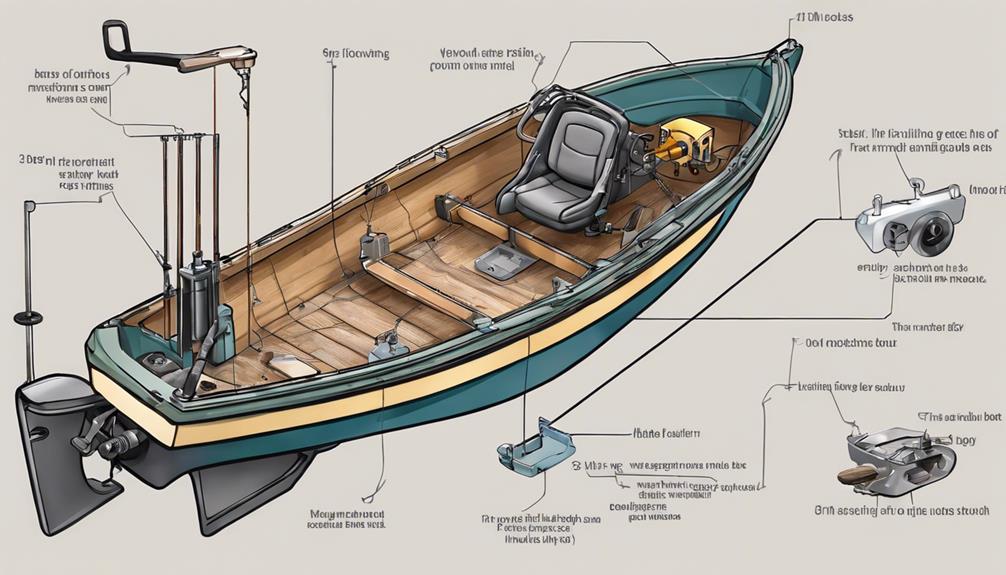
Ensure a secure and stable mounting for your trolling motor by following these essential installation tips. When installing your trolling motor, it's crucial to pay attention to mounting techniques and safety precautions to prevent any mishaps. Here are some key tips to guide you through the installation process:
- Check Compatibility: Before starting the installation, ensure that the trolling motor is compatible with your boat's size and weight capacity to avoid any issues later on.
- Use Quality Mounting Hardware: Invest in high-quality mounting hardware to ensure a secure attachment of the trolling motor to your boat's bow or transom.
- Secure Electrical Connections: Double-check all electrical connections to prevent loose wiring or potential electrical hazards while out on the water.
- Properly Seal Drill Holes: When drilling holes for mounting, make sure to seal them properly to prevent water leakage into the boat.
- Balance Weight Distribution: Consider the weight distribution of your boat to ensure that adding the trolling motor doesn't disrupt the balance, affecting the boat's performance.
Maintenance and Care Tips
Regular maintenance of your trolling motor is essential to ensure optimal performance and longevity. To keep your trolling motor in top condition, it's crucial to follow proper cleaning techniques and storage practices. After each use, rinse the motor with freshwater to remove any salt or debris that could cause corrosion. Periodically, use a mild soap and water to clean the exterior of the motor and inspect it for any signs of wear or damage.
When storing your trolling motor, ensure it's completely dry to prevent mold or rust buildup. Store it in a cool, dry place away from direct sunlight to avoid damage from UV rays. Consider covering it with a protective cover to shield it from dust and moisture during long periods of inactivity.
In case you encounter any issues with your trolling motor, it's important to be familiar with troubleshooting and basic repairs. Check the motor's connections, battery, and propeller regularly for any loose parts or malfunctions. Refer to the manufacturer's manual for guidance on common problems and solutions. If you're unable to resolve the issue on your own, seek professional assistance to prevent further damage.
Frequently Asked Questions
What Is the Difference Between a Transom Mount and a Bow Mount Trolling Motor?
When choosing between a transom mount and a bow mount trolling motor, consider the installation process. Transom mounts are easier to install at the back of your boat, while bow mounts require more effort on the front.
Additionally, bow mounts often offer better steering capabilities with remote control options, making them ideal for precise maneuvering.
In terms of power efficiency, both types can be efficient, but bow mounts typically provide smoother and more controlled movements.
Can I Use a Freshwater Trolling Motor in Saltwater Environments?
Yes, you can use a freshwater trolling motor in saltwater environments, but it's not recommended due to corrosion risks. Saltwater can damage the motor faster than freshwater.
Saltwater trolling motors are designed with better corrosion resistance to withstand the harsh environment. They also offer improved power efficiency, making them more suitable for saltwater use.
To ensure longevity and optimal performance, it's advisable to invest in a trolling motor specifically made for saltwater conditions.
How Do I Properly Store and Maintain My Trolling Motor During the Off-Season?
When it comes to proper maintenance and storage tips for your trolling motor during the off-season, remember to:
- Clean it thoroughly after each use to prevent corrosion.
- Store it in a dry, cool place away from direct sunlight.
- Charge the battery periodically to maintain its health.
- Check for any damage or wear and tear before storing it.
Proper maintenance now will ensure your trolling motor is ready to go when the fishing season starts again.
Are There Any Special Safety Precautions I Should Take When Using a Wireless Control Trolling Motor?
When using a wireless control trolling motor, ensure battery safety by using the correct type and following charging guidelines. Check the remote range to avoid losing control.
Make sure your motor is water-resistant and be cautious of interference risks in certain conditions. Prioritize safety by being aware of these factors to have a smooth and secure fishing experience with your trolling motor.
What Is the Average Lifespan of a Trolling Motor and When Should I Consider Replacing It?
When it comes to trolling motor maintenance, understanding the average lifespan is key. Typically, trolling motors last around 5-7 years with proper care.
Signs it's time for a replacement include decreased power, excessive noise, or erratic behavior. Regularly inspecting and cleaning your motor can help extend its lifespan.
If you notice performance issues despite maintenance efforts, it might be time to consider replacing your trolling motor for optimal functionality on the water.
Conclusion
When choosing a trolling motor for your fishing boat adventure, consider factors like:
- Freshwater or saltwater use
- Wireless control options
- Thrust power
- Battery life
- Mounting and installation
- Maintenance and care
Make sure to select a motor that fits your specific needs and preferences to enhance your fishing experience. Happy trolling!
